英语公开课评课记录表
教研评课议课活动记录
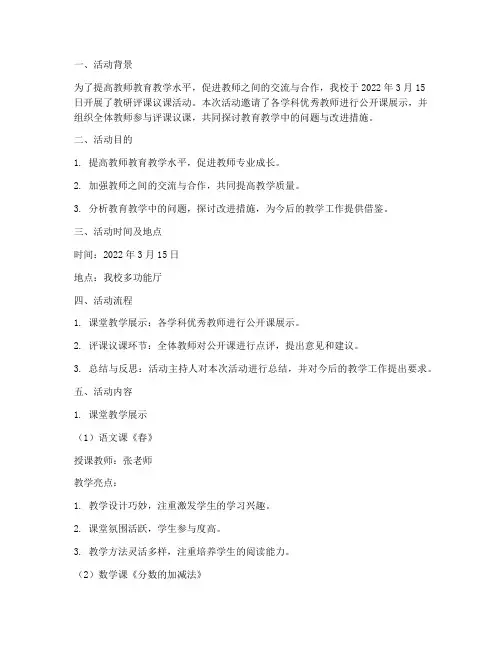
一、活动背景为了提高教师教育教学水平,促进教师之间的交流与合作,我校于2022年3月15日开展了教研评课议课活动。
本次活动邀请了各学科优秀教师进行公开课展示,并组织全体教师参与评课议课,共同探讨教育教学中的问题与改进措施。
二、活动目的1. 提高教师教育教学水平,促进教师专业成长。
2. 加强教师之间的交流与合作,共同提高教学质量。
3. 分析教育教学中的问题,探讨改进措施,为今后的教学工作提供借鉴。
三、活动时间及地点时间:2022年3月15日地点:我校多功能厅四、活动流程1. 课堂教学展示:各学科优秀教师进行公开课展示。
2. 评课议课环节:全体教师对公开课进行点评,提出意见和建议。
3. 总结与反思:活动主持人对本次活动进行总结,并对今后的教学工作提出要求。
五、活动内容1. 课堂教学展示(1)语文课《春》授课教师:张老师教学亮点:1. 教学设计巧妙,注重激发学生的学习兴趣。
2. 课堂氛围活跃,学生参与度高。
3. 教学方法灵活多样,注重培养学生的阅读能力。
(2)数学课《分数的加减法》授课教师:李老师教学亮点:1. 教学目标明确,重难点突出。
2. 教学过程清晰,环环相扣。
3. 课堂练习设计合理,有助于巩固所学知识。
(3)英语课《My Family》授课教师:王老师教学亮点:1. 教学内容丰富,注重培养学生的语言运用能力。
2. 教学方法灵活,善于调动学生的积极性。
3. 课堂氛围轻松愉快,学生乐于参与。
2. 评课议课环节(1)语文课《春》优点:1. 张老师的教学设计巧妙,激发了学生的学习兴趣。
2. 学生参与度高,课堂氛围活跃。
3. 教学方法灵活多样,注重培养学生的阅读能力。
改进建议:1. 适当增加学生的自主阅读时间,提高学生的阅读能力。
2. 加强对重点词句的讲解,帮助学生更好地理解课文内容。
(2)数学课《分数的加减法》优点:1. 李老师的教学目标明确,重难点突出。
2. 教学过程清晰,环环相扣。
3. 课堂练习设计合理,有助于巩固所学知识。
8AUnit3Maintask英语评课稿
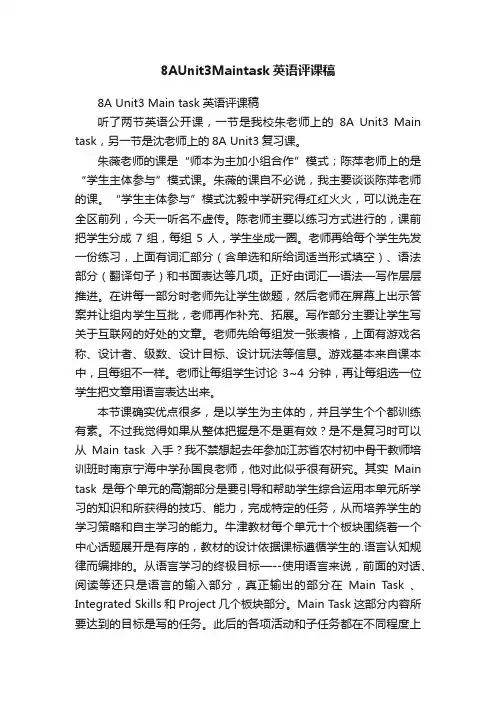
8AUnit3Maintask英语评课稿8A Unit3 Main task英语评课稿听了两节英语公开课,一节是我校朱老师上的8A Unit3 Main task,另一节是沈老师上的8A Unit3复习课。
朱薇老师的课是“师本为主加小组合作”模式;陈萍老师上的是“学生主体参与”模式课。
朱薇的课自不必说,我主要谈谈陈萍老师的课。
“学生主体参与”模式沈毅中学研究得红红火火,可以说走在全区前列,今天一听名不虚传。
陈老师主要以练习方式进行的,课前把学生分成7组,每组5人,学生坐成一圈。
老师再给每个学生先发一份练习,上面有词汇部分(含单选和所给词适当形式填空)、语法部分(翻译句子)和书面表达等几项。
正好由词汇—语法—写作层层推进。
在讲每一部分时老师先让学生做题,然后老师在屏幕上出示答案并让组内学生互批,老师再作补充、拓展。
写作部分主要让学生写关于互联网的好处的文章。
老师先给每组发一张表格,上面有游戏名称、设计者、级数、设计目标、设计玩法等信息。
游戏基本来自课本中,且每组不一样。
老师让每组学生讨论3~4分钟,再让每组选一位学生把文章用语言表达出来。
本节课确实优点很多,是以学生为主体的,并且学生个个都训练有素。
不过我觉得如果从整体把握是不是更有效?是不是复习时可以从Main task入手?我不禁想起去年参加江苏省农村初中骨干教师培训班时南京宁海中学孙国良老师,他对此似乎很有研究。
其实Main task是每个单元的高潮部分是要引导和帮助学生综合运用本单元所学习的知识和所获得的技巧、能力,完成特定的任务,从而培养学生的学习策略和自主学习的能力。
牛津教材每个单元十个板块围绕着一个中心话题展开是有序的,教材的设计依据课标遵循学生的.语言认知规律而编排的。
从语言学习的终极目标—--使用语言来说,前面的对话、阅读等还只是语言的输入部分,真正输出的部分在Main Task 、Integrated Skills和Project几个板块部分。
助学支教英语公开课评课流程及内容
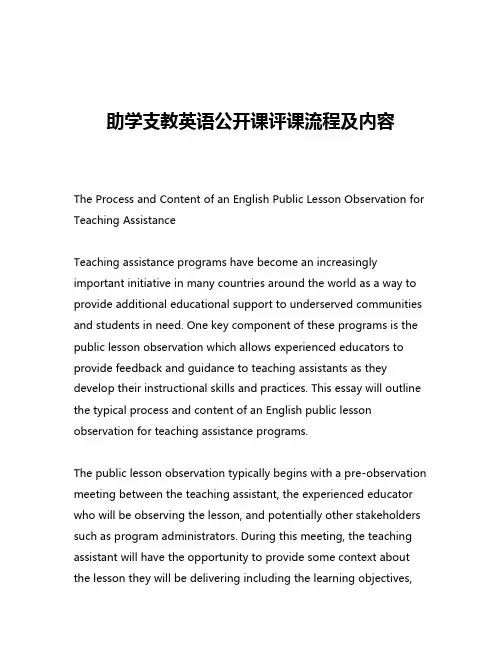
助学支教英语公开课评课流程及内容The Process and Content of an English Public Lesson Observation for Teaching AssistanceTeaching assistance programs have become an increasingly important initiative in many countries around the world as a way to provide additional educational support to underserved communities and students in need. One key component of these programs is the public lesson observation which allows experienced educators to provide feedback and guidance to teaching assistants as they develop their instructional skills and practices. This essay will outline the typical process and content of an English public lesson observation for teaching assistance programs.The public lesson observation typically begins with a pre-observation meeting between the teaching assistant, the experienced educator who will be observing the lesson, and potentially other stakeholders such as program administrators. During this meeting, the teaching assistant will have the opportunity to provide some context about the lesson they will be delivering including the learning objectives,the lesson activities, and any specific areas they would like the observer to focus on. This allows the observer to understand the teaching assistant's goals and intentions for the lesson and tailor their feedback accordingly.Next, the public lesson observation itself takes place. The experienced educator will observe the teaching assistant delivering the lesson to a class of students. Throughout the observation, the observer will take detailed notes on various aspects of the lesson including the teaching assistant's instructional techniques, their engagement and rapport with students, the pacing and flow of the lesson, the clarity of the explanations and instructions provided, the suitability of the lesson activities and resources, and the overall effectiveness in achieving the stated learning objectives.The observer will also make note of any positive aspects of the lesson that the teaching assistant can build upon as well as any areas for improvement. Particular attention will be paid to the teaching assistant's use of the English language, both in terms of their own fluency and accuracy as well as their ability to effectively model and scaffold English language learning for the students.Following the observation, the teaching assistant and observer will reconvene for a post-observation meeting. During this meeting, the observer will provide detailed feedback to the teaching assistant,highlighting the strengths they observed as well as the areas that could be improved. This feedback will be constructive and focused on providing the teaching assistant with concrete strategies and recommendations for enhancing their instructional practice.The observer may, for example, provide suggestions for better managing student behavior, adapting lesson activities to meet the needs of diverse learners, or enhancing the clarity of their English language explanations. They may also offer advice on effective lesson planning techniques, the use of instructional resources and technology, or ways to foster greater student engagement and participation.Throughout the feedback session, the teaching assistant will have the opportunity to ask clarifying questions, share their own reflectionson the lesson, and engage in a collaborative dialogue with the observer. This allows the teaching assistant to gain a deeper understanding of the observer's assessment and to identify concrete steps they can take to improve their teaching.In addition to the verbal feedback provided during the post-observation meeting, the observer will also typically prepare a written report summarizing their observations and recommendations. This report can serve as a valuable reference for the teaching assistant as they continue to develop their skills and can also beshared with program administrators to inform ongoing professional development and support.The content of the public lesson observation feedback will cover a wide range of instructional and pedagogical areas. In terms of lesson planning and design, the observer may comment on the clarity and appropriateness of the learning objectives, the coherence and logical flow of the lesson activities, and the alignment between the lesson plan and the actual delivery.Classroom management strategies will also be a key focus, with the observer providing feedback on the teaching assistant's ability to establish and maintain a positive, productive learning environment. This may include comments on their use of behavior management techniques, their strategies for engaging and motivating students, and their ability to effectively transition between different lesson activities.The teaching assistant's English language proficiency and their ability to model and support English language development in students will be another central aspect of the observation and feedback. The observer will assess the teaching assistant's own command of English grammar, vocabulary, pronunciation, and fluency, as well as their effectiveness in scaffolding English language learning through their instructional practices.Closely related to this is the observer's assessment of the teaching assistant's ability to differentiate instruction and adapt their teaching to meet the diverse needs of the students. This may involve comments on the suitability and accessibility of the lesson materials and resources, the variety of instructional strategies employed, and the teaching assistant's responsiveness to student questions, misconceptions, and learning styles.Finally, the observer will provide feedback on the teaching assistant's overall instructional effectiveness, focusing on their ability to engage students, facilitate meaningful learning experiences, and achieve the intended learning outcomes. This may include comments on the teaching assistant's use of questioning techniques, their ability to provide clear explanations and instructions, and their skill in assessing student understanding and providing appropriate feedback.Throughout the public lesson observation process, the goal is to provide the teaching assistant with detailed, constructive feedback that they can use to continuously improve their instructional practice and become more effective educators. The observer's role is not to simply evaluate the teaching assistant's performance, but to collaborate with them in identifying areas for growth and developing concrete strategies for professional development.By participating in this public lesson observation process, teaching assistants gain valuable insights and guidance that can help them strengthen their teaching skills, increase their confidence, and ultimately have a greater positive impact on the students they serve. It is a critical component of many teaching assistance programs and an important means of supporting the professional development of educators working in underserved communities.。
初中英语听评课教研记录(3篇)
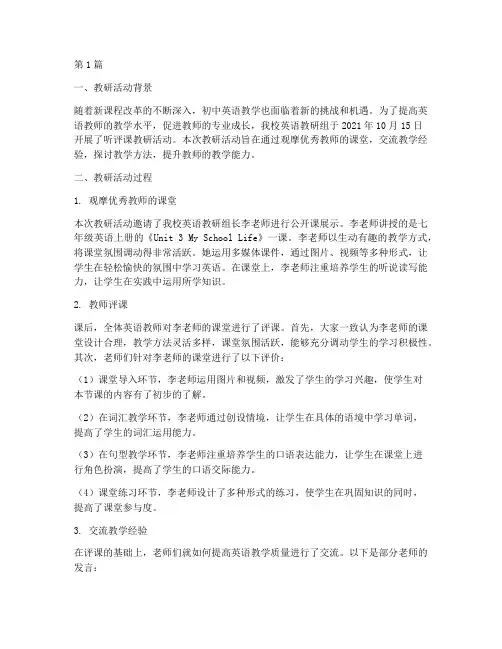
第1篇一、教研活动背景随着新课程改革的不断深入,初中英语教学也面临着新的挑战和机遇。
为了提高英语教师的教学水平,促进教师的专业成长,我校英语教研组于2021年10月15日开展了听评课教研活动。
本次教研活动旨在通过观摩优秀教师的课堂,交流教学经验,探讨教学方法,提升教师的教学能力。
二、教研活动过程1. 观摩优秀教师的课堂本次教研活动邀请了我校英语教研组长李老师进行公开课展示。
李老师讲授的是七年级英语上册的《Unit 3 My School Life》一课。
李老师以生动有趣的教学方式,将课堂氛围调动得非常活跃。
她运用多媒体课件,通过图片、视频等多种形式,让学生在轻松愉快的氛围中学习英语。
在课堂上,李老师注重培养学生的听说读写能力,让学生在实践中运用所学知识。
2. 教师评课课后,全体英语教师对李老师的课堂进行了评课。
首先,大家一致认为李老师的课堂设计合理,教学方法灵活多样,课堂氛围活跃,能够充分调动学生的学习积极性。
其次,老师们针对李老师的课堂进行了以下评价:(1)课堂导入环节,李老师运用图片和视频,激发了学生的学习兴趣,使学生对本节课的内容有了初步的了解。
(2)在词汇教学环节,李老师通过创设情境,让学生在具体的语境中学习单词,提高了学生的词汇运用能力。
(3)在句型教学环节,李老师注重培养学生的口语表达能力,让学生在课堂上进行角色扮演,提高了学生的口语交际能力。
(4)课堂练习环节,李老师设计了多种形式的练习,使学生在巩固知识的同时,提高了课堂参与度。
3. 交流教学经验在评课的基础上,老师们就如何提高英语教学质量进行了交流。
以下是部分老师的发言:(1)张老师:在英语教学中,我们要注重培养学生的听说读写能力,让学生在实践中运用所学知识。
(2)王老师:课堂导入环节非常重要,我们要运用多种形式激发学生的学习兴趣。
(3)刘老师:在词汇教学环节,我们要注重语境的创设,让学生在具体的语境中学习单词。
(4)李老师:课堂练习环节要多样化,提高学生的课堂参与度。
公开课教师评课记录

公开课教师评课记录一、教师仪表本次公开课,李老师的仪表朴素、自然、大方,衣着得体,情绪饱满,教态亲切自然,显得特别有感染力。
在课堂一开始,李老师用亲和的语言把孩子们带入自己的教学情境中,拉近了师生之间的距离。
在执教过程中,李老师始终面带微笑,给人以亲切之感。
二、教学思路这堂课的总体思路很清晰:通过师生互动来检查学生的基础知识;通过质疑来挖掘文本中的内涵;通过拓展延伸来达到提升学生能力的目标。
从整体来看,这条思路是符合学生认知规律的。
在教学过程中,李老师设计了一系列环环相扣的问题,逐步引导学生去探讨、去感悟,充分体现了“以人为本”的教学思想。
三、教学方法在这堂课中,李老师采用了多种教学方法。
在导入新课时,她通过亲切自然的师生问候来拉近学生与老师的距离;在教学过程中,她采用了提问法、讨论法、表演法等多种教学方法来调动学生的积极性。
这些教学方法的运用使得整堂课的气氛十分活跃。
四、教学基本功李老师具有扎实的教学基本功。
她的语言清晰流畅、板书工整美观、教态自然大方。
在教学过程中,她能够灵活地运用各种教学方法和手段来引导学生进行思考和讨论。
她还具备了一定的课堂调控能力,能够及时发现并处理学生在课堂上出现的问题。
五、教学效果本次公开课的教学效果比较显著。
李老师通过生动有趣的讲解和引导,使得学生们对文本有了更加深入的理解和认识。
在师生互动环节中,学生们积极参与、思维活跃,课堂气氛十分活跃。
通过这堂公开课的学习,学生们不仅掌握了基础知识,还提高了自己的阅读能力和思维能力。
本次公开课中,李老师表现出了较高的教学素养和扎实的教学基本功。
她的教学思路清晰、教学方法多样、教学效果显著。
她还具备了一定的课堂调控能力和师生互动能力。
这些优点值得我们学习和借鉴。
公开课评课主持词各位领导、老师:大家好!感谢各位参加本次的公开课活动。
本学期的公开课活动已经圆满结束,感谢各位老师的精心准备和精彩授课。
在本次公开课活动中,我们看到了很多优秀的教师,他们以不同的方式展示了各自独特的教学风格和教学理念。
2018-英语课评课记录-word范文 (4页)
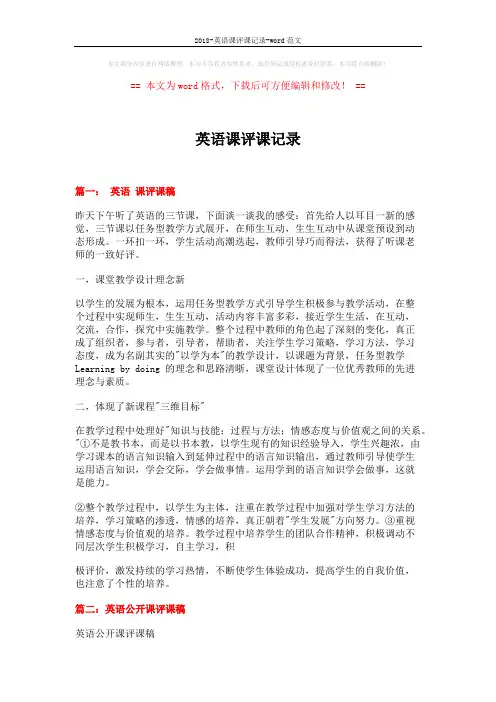
本文部分内容来自网络整理,本司不为其真实性负责,如有异议或侵权请及时联系,本司将立即删除!== 本文为word格式,下载后可方便编辑和修改! ==英语课评课记录篇一:英语课评课稿昨天下午听了英语的三节课,下面谈一谈我的感受:首先给人以耳目一新的感觉,三节课以任务型教学方式展开,在师生互动,生生互动中从课堂预设到动态形成。
一环扣一环,学生活动高潮迭起,教师引导巧而得法,获得了听课老师的一致好评。
一,课堂教学设计理念新以学生的发展为根本,运用任务型教学方式引导学生积极参与教学活动,在整个过程中实现师生,生生互动,活动内容丰富多彩,接近学生生活,在互动,交流,合作,探究中实施教学。
整个过程中教师的角色起了深刻的变化,真正成了组织者,参与者,引导者,帮助者,关注学生学习策略,学习方法,学习态度,成为名副其实的"以学为本"的教学设计,以课题为背景,任务型教学Learning by doing 的理念和思路清晣,课堂设计体现了一位优秀教师的先进理念与素质。
二,体现了新课程"三维目标"在教学过程中处理好"知识与技能;过程与方法;情感态度与价值观之间的关系。
"①不是教书本,而是以书本教,以学生现有的知识经验导入,学生兴趣浓,由学习课本的语言知识输入到延伸过程中的语言知识输出,通过教师引导使学生运用语言知识,学会交际,学会做事情。
运用学到的语言知识学会做事,这就是能力。
②整个教学过程中,以学生为主体,注重在教学过程中加强对学生学习方法的培养,学习策略的渗透,情感的培养,真正朝着"学生发展"方向努力。
③重视情感态度与价值观的培养。
教学过程中培养学生的团队合作精神,积极调动不同层次学生积极学习,自主学习,积极评价,激发持续的学习热情,不断使学生体验成功,提高学生的自我价值,也注意了个性的培养。
篇二:英语公开课评课稿英语公开课评课稿本节课的内容是七年级下册Unit6 topic 2 sectionB部分,整节课教师很好地贯彻了英语教学提倡的交际性原则,并且运用了多种教学手段及方法以达到教学目标,也能很好地调动学生的学习积极性与学习兴趣。
初中英语听课记录
初中英语听课记录初中英语听课记录第一篇听课人:林芸莹,谢玉贞,吴美辉,李敏,谢静雪,邱燕珠听课地点:梅师附小听课时间:第七周星期三听课目的:了解小学的基本情况,了解学习班主任工作的职责,了解少先队活动情况,了解小学课堂和课后其他工作情况,更好地学好专业知识,巩固专业思想。
学校课题梅师附小Myfriend课堂记录1.早读:学生齐读上一单元的课文、单词班级四第一节学科执教人英语叶梅听课意见早读有助于学生记忆之前学习内容,起到温故知新的作用。
但个别单词的读音得注意一下,例如book、math、English等利用音像资料进行课程回顾,生动有趣,很大程度地提高学生对之前学过内容的记忆力。
2.回顾:1)let’sdo.出示课件录像:tall,tall,makeyourselftall.\short,short,makeyourselfshort.\big,big,makeyoureyesbig.\small,small,makeyoureyessmall.\lon g,long,makeyourarmslong.\short,short,makeyourarmsshort.师生一起随录像做动作。
2)let’sguess.a.老师描述一种动物让学生猜:it’ssmall.Ithastwolongears.Whatisit?(rabbit)b.老师出示课件图片让学生描述:describemoney3.引入:出示图片让学生说说他有什么特征,再引出新单词4.带读friend、longhair、shorthair,之后让学生描述他的同桌5.再用图片引入新的单词thin、strong、quiet,再让学生描述他的同学6.let’sfindout:老师先描述一个人的外貌特点让学生找出他的图片:myfriendisjohn,hehasshorthairandbideyes.Heistall.Whoisit?之后播放录音(课本P28),让学生找出对应的图片。
高中英语听课评课记录
高中英语听课评课记录听课评课记录:高中英语课堂时间:2024年1月20日地点:高中英语教室授课教师:张老师听课人:李老师、刘老师等一、授课内容概述本节课是高中英语课程中的一节阅读课,授课内容为《项链》的节选。
老师通过引导学生阅读文本,理解故事情节和人物特点,以及分析文本中的语言点和写作技巧,旨在提高学生的阅读理解能力和写作技巧。
二、教学方法和手段老师采用了任务型教学法,通过设置一系列的任务,引导学生积极参与课堂活动,提高学生的学习兴趣和主动性。
在阅读过程中,老师采用了一些有效的阅读策略,如预测、略读、扫读等,帮助学生快速理解文本内容。
老师运用多媒体教学辅助手段,展示了相关图片和视频素材,帮助学生更好地理解故事情节和人物特点。
三、师生互动情况老师在课堂上注重与学生互动,通过提问、讨论等方式引导学生思考和表达自己的观点。
老师对学生的回答给予及时的反馈和评价,鼓励学生积极参与课堂活动,增强了学生的自信心。
在小组活动中,学生之间互相交流和合作,共同完成任务,培养了学生的合作意识和沟通能力。
四、课堂氛围与纪律课堂氛围积极向上,学生在课堂上表现出浓厚的兴趣和热情。
老师对课堂纪律要求严格,学生在课堂上认真听讲、积极参与活动,没有出现违纪行为。
五、教学效果与建议本节课的教学效果较好,学生的阅读理解能力和写作技巧得到了有效提高。
建议老师在今后的教学中,进一步优化教学方法和手段,提高课堂教学效果。
例如,可以尝试运用更多的教学策略,如小组讨论、角色扮演等,以激发学生的学习兴趣和参与度。
同时,老师还可以结合学生的实际情况,增加一些有针对性的练习和训练,提高学生的英语实际应用能力。
另外,建议老师注重培养学生的思维能力和批判性思维能力,鼓励学生在课堂上提出自己的观点和见解,培养学生的创新精神和实践能力。
最后,建议老师关注学生的个体差异和需求,针对不同层次的学生制定个性化的教学方案,促进全体学生的全面发展。
英语公开课活动记录
初中英语教研活动记录教研地点:多媒体教室主持人:史小茹参与人员:王雅玲陈红霞赵代娣单文敏姚彩梅郭伟伟活动内容:讨论单文敏老师的县优质课评比试讲课具体内容:(一)英语教研组成员评课:陈红霞:该教师在教学过程中牢牢地抓住了学生的注意力,不失时机地精心制造教学的亮点,把课堂教学推向了高潮,使学生达到情绪高涨、智力振奋的积极状态。
教师在实施本节课教学中,教学目的明确、重难点突出,教法灵活科学,讲课时思路清晰,善于调动学生学习的积极性,课堂驾驭能力强。
赵代娣:教师的设疑,有效地激发了学生的学习兴趣及求知欲,让学生在无心理压力的情况下自主地参与学习,留给了学生充分的空间去展示会个性及能力,同时教师也很好地发挥了主导作用。
王雅玲:教师语音标准,能给学生起示范作用。
英语基本功扎实,教态亲切自然。
巧妙地运用了语言描述及提问等方式创设了一个情境,让学生入景动情,使其受到感染,并以积极的态度投入到学习中。
郭伟伟:纵观整节课,学生学习热情高涨,师生互动好,配合默契,取得了较好的学习效果。
这次教学活动是一次单词、短语、句型的组合教学活动,教师注重学生听、说、读、写各种技能的培养,有效地提高了学生的英语综合能力,同时,教师扎实的教学功底也得到了淋漓尽致的体现。
史小茹:本节课教学的精彩之处在于把学生的学习积极性调动起来,激活学生的思维。
教师善于点拨、引导,激发学生对学习的兴趣,从而推动学生进入了积极思维的状态,为本节课堂的精彩教学作了充分的准备。
课堂上教师饱满的热情、最佳的心境和高昂的教学激情感染了学生,调动了教学气氛,使学生在心理上产生共振,进入了最佳的学习状态,教学效果显著。
教师准确地把握了设疑的方向,设置了学生感兴趣的问题,充分调动了学生学习的兴趣,使学生进入了积极的思维状态。
(二)针对本课建议措施:陈红霞:分组可将座位邻近的学生组成两人一组或多人一组的学习小组,每组选一个有协调能力和责任心的小组长,协调本组关系,检查评价合作情况,向教师反馈成语,关心帮助组成绩不好的学生等。
高中英语公开课听评课记录范文
高中英语公开课听评课记录范文Here is an essay on the topic of "High School English Public Lesson Observation Record" with more than 1000 words, written in English without any additional punctuation marks in the main body.The high school English public lesson observation is an essential component of the professional development of English teachers in China. It provides a platform for teachers to showcase their teaching skills, receive feedback, and learn from their peers. As an English teacher myself, I have had the privilege of participating in several public lesson observations, and I would like to share my experience and reflections on this valuable practice.The primary purpose of the high school English public lesson observation is to promote the exchange of teaching ideas and strategies among teachers. During these sessions, a teacher is selected to deliver a lesson in front of their colleagues, who then observe and provide feedback on various aspects of the lesson. The observation process typically involves a pre-observation meeting, the actual lesson delivery, and a post-observation discussion.In the pre-observation meeting, the observing teachers and thelesson presenter discuss the lesson plan, the learning objectives, and the teaching strategies that will be employed. This allows the observing teachers to gain a deeper understanding of the lesson and to identify areas they would like to focus on during the observation.During the lesson delivery, the observing teachers carefully monitor the teacher's performance, taking notes on the effectiveness of the teaching methods, the engagement of the students, and the achievement of the learning objectives. They also observe the teacher's use of language, their classroom management skills, and their ability to respond to unexpected situations.The post-observation discussion is the most valuable part of the process. This is where the observing teachers provide feedback and suggestions to the lesson presenter. They may highlight the strengths of the lesson, offer constructive criticism, and share their own experiences and strategies that could be incorporated into the lesson. The discussion is often lively and thought-provoking, as teachers engage in a professional dialogue and learn from one another.One of the key benefits of the high school English public lesson observation is the opportunity for professional growth. By observing and providing feedback to their peers, teachers can gain new insights into their own teaching practices and identify areas forimprovement. They may discover innovative teaching strategies, learn how to better engage students, or find ways to enhance their classroom management skills.Moreover, the public lesson observation fosters a sense of community among English teachers. It encourages collaboration and the sharing of best practices, which can lead to the development of a strong professional network. This network can be invaluable for teachers seeking support, resources, or guidance in their teaching careers.Another important aspect of the high school English public lesson observation is its role in the evaluation and promotion of teachers. Many schools and education authorities use the observation process as a tool to assess the teaching abilities of their faculty members. The feedback and ratings provided by the observing teachers can be used to identify outstanding teachers, provide targeted professional development opportunities, and make informed decisions about promotions and career advancement.However, the high school English public lesson observation is not without its challenges. One of the most significant challenges is the potential for performance anxiety among the lesson presenters. The pressure of delivering a lesson in front of their colleagues can be overwhelming, and it may lead to a less than optimal performance.To mitigate this, some schools have implemented strategies such as providing more preparation time, offering emotional support, and emphasizing the learning-focused nature of the observation process.Another challenge is the potential for bias and subjectivity in the feedback provided by the observing teachers. Different teachers may have varying perspectives on what constitutes effective teaching, and their feedback may be influenced by their own teaching styles and personal preferences. To address this issue, some schools have implemented more structured feedback protocols, with clear evaluation criteria and guidelines for providing constructive feedback.Despite these challenges, the high school English public lesson observation remains an essential component of the professional development of English teachers in China. It provides a valuable opportunity for teachers to learn from one another, improve their teaching skills, and contribute to the overall quality of English education in the country.In conclusion, the high school English public lesson observation is a crucial practice that supports the professional growth and development of English teachers. It fosters collaboration, encourages the sharing of best practices, and contributes to the evaluation and promotion of teachers. While there are challenges to be addressed, the benefits of this practice far outweigh the drawbacks, and it is apractice that should be continued and refined to ensure the ongoing improvement of English education in China.。
